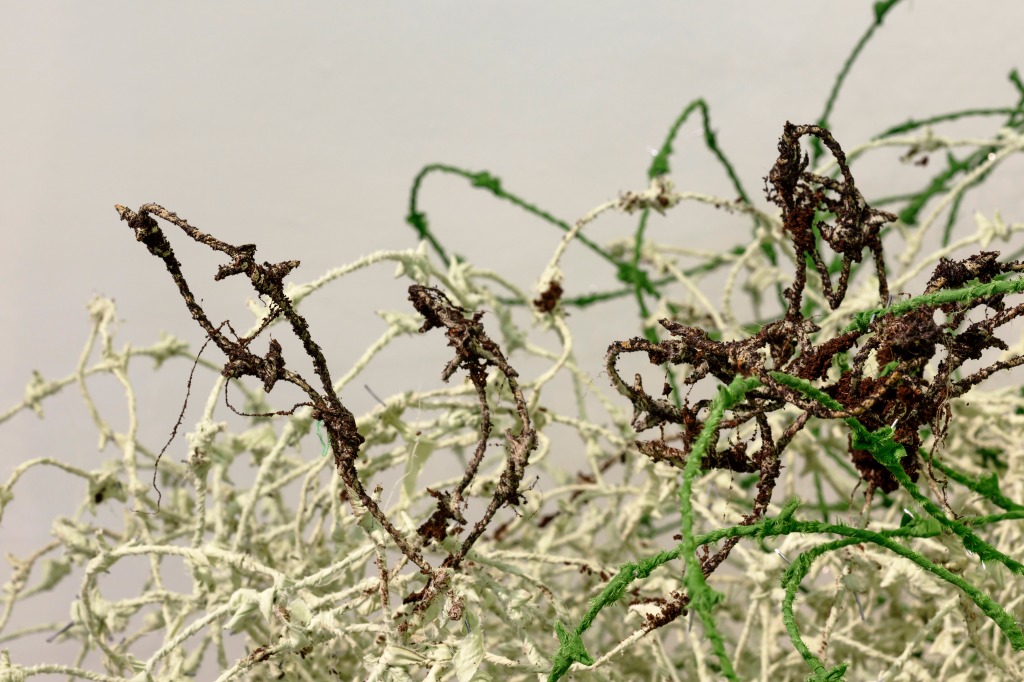 Lungiswa Gqunta: Noluthando; Kholiswa; River Beds (detail), 2021. Photo Axel Schneider
Lungiswa Gqunta: Noluthando; Kholiswa; River Beds (detail), 2021. Photo Axel Schneider  Detail of Lungiswa Gqunta’s Noluthando; Kholiswa; River Beds, 2021. Photo Diana Pfammatter
Detail of Lungiswa Gqunta’s Noluthando; Kholiswa; River Beds, 2021. Photo Diana Pfammatter
Caring for land can result in abundant harvests. But when human connections to the land get severed—whether by ecological disaster or colonialism—harvest time can exist only in dreams. This is the premise behind South African artist Lungiswa Gqunta’s solo exhibition “Tending to the Harvest of Dreams,” on view at the Museum für Moderne Kunst in Frankfurt through November 14. The show responds to South Africa’s Natives Land Act of 1913, in which the segregationist government allocated only 7% of the nation’s productive land to the Black majority, whose members were relegated to these “native reserves.”
Gqunta typically creates sculptural assemblages and installations using found materials—empty beer bottles, old bedsheets, razor wire, and discarded bed frames—all of which are ubiquitous within the urban township of her birthplace, New Brighton. Her newest work is an installation in the form of an immersive garden. But instead of flora and fauna, her dreamscape is filled with metal riverbeds and shrubs made of barbed wire. The installation highlights how the Land Act’s legacy continues to be felt—there’s been hardly any successful land ownership reform in the nation since it attained full democracy status in 1994.
The space is also permeated by the sound of Gqunta’s recorded voice recalling a dream in Xhosa. She recites dreams as part of her spiritual practice, recording her recitations so she can consult with a guide. A string of seemingly random thoughts, the dreams are largely unintelligible, even to those who understand her language. The opacity is deliberate—a way of keeping the spiritual aspects of her practice sacred. The show continues Gqunta’s quest to unearth the hidden structures of violence buried just beneath the surface of the South African landscape, and to construct an alternative present through spirituality and dreams.
 View of Lungiswa Gqunta’s exhibition “Tending to the Harvest of Dreams,” 2021, at the Museum für Moderne Kunst, Frankfurt. Photo Diana Pfammatter
View of Lungiswa Gqunta’s exhibition “Tending to the Harvest of Dreams,” 2021, at the Museum für Moderne Kunst, Frankfurt. Photo Diana Pfammatter
The sculptural works are made with barbed wire wrapped in green and purple fabric. For the artist, binding and wrapping the material transforms it into “plant-like things that begin to grow into space, naturally unwinding into whatever they want to be.” She sees the process as a meditative act of care akin to hair braiding. The fabric does not completely conceal the ferocity of the wire—the spikes resist and poke through the fabric. The work reflects on the ways in which it is difficult to conceal or build on top of the violent legacies of colonialism.
Gqunta began working on the installation’s wire sculptures during her 2018 residency at Gasworks, London. The year prior, she performed in Documenta 14 with the iQhiya Collective, a group of eleven Black women artists launched when they were all students at the Michaelis School of Fine Arts in Cape Town. Gqunta also mounted her first solo exhibition in 2017, at Kelder Projects in London. The show included a sculpture called Sleeping Pools (2017), for which she lined a metal bed frame with LED lights and sealed petrol in clear plastic, evoking a haunting swimming pool—an image of suburban luxury disrupted by the material used to intensify flames during protests. In her various gardens and pools, Gqunta reconstructs the symbols of privilege and safety often found in South African suburbs, continually evoking nature through mass-produced objects. Her choice to highlight the dismal nature of her material surroundings only emphasizes the appeal of the alternative spiritual realms she conjures alongside them.
Source link : https://www.artnews.com/art-in-america/features/lungiswa-gqunta-decolonial-dreams-and-immersive-garden-1234604373












